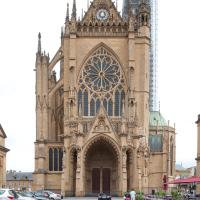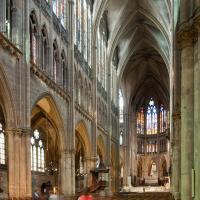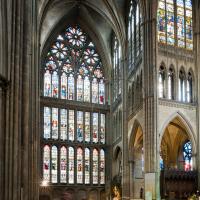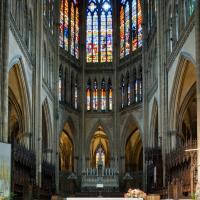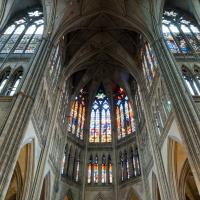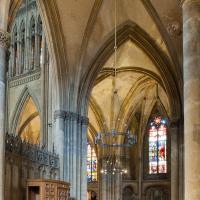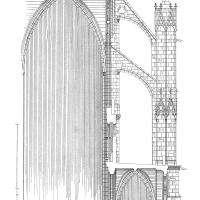Images
Notes
Date
Begun 1240
Sculptural Program
Although the sculptural program at Metz has undergone extensive restorations, the south porch has retained a significant amount of its medieval sculpture. That said, this portal, too, garnered attention from restorers, and thus we must tread lightly when considering its sculpture. Paul Vitry's account of the sculpture at Metz is useful in determining which portions date to the thirteenth-century program. We know, for instance, that the trumeau is modern, but that the central tympanum maintains much of its original aspect. As Willibald Sauerländer has described, when this portal was revealed in the second half of the nineteenth century, the jamb figures, trumeau figure, and archivolts were missing; these gaps were subsequently filled with nineteenth-century fabrications. In the lateral tympana, the iconography has been preserved; however, many figures have been reworked or replaced entirely by modern work.
The central tympanum depicts the Coronation of the Virgin. In the upper lintel is the Dormition of the Virgin. Christ is centered behind the deathbed, and two apostles and six angels also surround the Virgin. In the lower lintel are the ten remaining apostles, who hover around angels.
The linear drapery of the tympanum figures looks back in time to the late twelfth and early thirteenth centuries, whereas the relatively soft drapery of the figures in the lower registers is more in the vein of Reims and Paris.
Two subsidiary tympana project at acute angles from this doorway. In the left panel, the figures in the tympanum and in the register below are all modern. The right panel, which features scenes from the Passion, includes sculpture that was reworked in the nineteenth century; however, photographic evidence from its pre-restoration state suggests that the iconography and much of the stone itself date to the thirteenth century. The Crucifixion is represented in the tympanum of this panel, and the Flagellation and Christ Carrying the Cross appear in the lower register.
From the original fragments that survive, this portal has been dated to the 1240s. It echoes the Reims transept in terms of style and layout.
Location
Bibliography
Aubert, Marcel, ed. La cathédrale de Metz. Paris: Éditions Auguste Picard, 1931.






